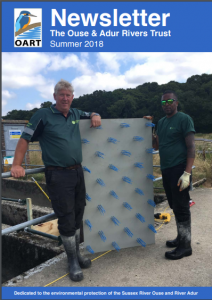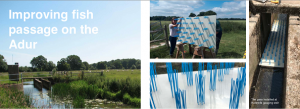Improving fish passage on the Adur by Rachel Paget
Ouse and Adur River Trust Newsletter. Summer 2018. https://oart.org.uk/wp-content/uploads/2018/10/OART-11-Summer-2018-E-Newsletter-1.pdf
OART have installed a new fish pass at Haterell’s Bridge, removing a significant barrier to fish passage on the Western arm of the River Adur and facilitating increased, multi-species, fish movement through an additional 2.2km of river.
The project, which was funded by the Environment Agency, used a novel new solution developed by Daniella Montali-Ashworth, a postgraduate researcher at the University of Southampton. The new pass design which has been developed for triangular gauging weirs consists of staggered clumps of flexible brushes fixed on 12mm plastic board which together create a unique hydrodynamic environment where fish passage is still improved without compromising the hydrometric properties of the weir. Low velocity areas form downstream of the cylinders which provide resting areas for ascending fish. Manufactured in 1.5m sections, for easy transport the pass required some small adjustments (a section had to be sawn off the side!) before being fixed to the cleaned concrete bed of the weir with expansion bolts. The simple materials make it extremely low cost and quick and easy to fit. The only difficult consideration is careful siting of the upstream board to maintain the gauging accuracy of the weir.
The pass at Haterell’s is only the second of its kind to be installed in the UK. The first being installed at Sakeham weir in 2017. Already results from the Sakeham trial have informed and improved the specification for Haterell’s and metal washers were situated underneath the pass to create a small gap which will allow for the movement of elvers. The boards which are currently white/grey will soon colour up with algae and naturalise into the river over the coming months. Looking to the future the Environment Agency are currently investigating whether single clusters would be better than fixed boards, so that the bases don’t need to be trimmed and the fish pass can work for any site geometry. The free passage of migratory fish is a key requirement of the Water Framework Directive and the River Adur supports a good population of resident brown trout along with migratory sea trout which move in from the sea during the summer months up into the upper reaches where, during the winter months, they will spawn on gravels in the channel bed. Many thanks to the landowners for their support for the project and for allowing easy access to the river and to David Gilbert and Patrick Murray from the Environment Agency West Sussex Operations Team who installed the pass. A brilliant job and a great result for the fish population.

